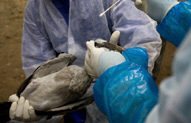



US Announces Boost For FAO’s Bird Flu Programme
ROME - The United States will support FAO’s avian influenza control and prevention programme with an additional US$38 million, FAO announced today. The United States is one of the biggest donors to the agency’s programme.With the new funding, US support to the FAO avian influenza programme has reached a total of about $63 million.
FAO is currently assisting more than 100 countries in their efforts to prevent and control avian influenza.
The United States Agency for International Development (USAID) said in a letter to FAO that the contribution will be earmarked for core Highly Pathogenic Avian Influenza containment and control activities, including in-country surveillance and early warning, efforts to reduce disease transmission, and communication to increase public awareness and preparedness.
Confidence
 |
| Sufficient funding is essential to continue bird flu control and prevention campaigns. |
"Our latest contribution reaffirms the confidence we place in FAO to contain and control Highly Pathogenic Avian Influenza at its animal source. Lending support to countries through FAO remains a key element in managing the global risk," said Ambassador Gaddi Vasquez of the US Mission to FAO.
“This new contribution from USAID is a welcome expression of trust in FAO’s global leadership in the fight against avian influenza,” said Anne M. Bauer, Director of FAO’s Emergency Operations and Rehabilitation Division.
The new money will go into ongoing and new surveillance and response, planning, training, logistics, technical, laboratory, and communication projects and activities in western, eastern and southern Africa, Southeast Asia, the Indian sub-continent, Central Asia, central/eastern Europe, Indonesia and Egypt.
Involving local communities
Cross-border surveillance and the more active involvement of local communities and village animal health workers in control and response activities will be some of the priority areas to be supported with US funding. Fresh money is also being directed at FAO’s current work on the socio-economic impact of HPAI, biosecurity and wild bird surveillance.
USAID specified that as part of its support to FAO’s efforts to control HPAI globally, it was particularly interested in backing the UN agency’s aim to establish an avian influenza communications capacity.
New US funds will also go to the Crisis Management Centre – Animal Health, an emergency response unit run by FAO, which in collaboration with the World Organisation for Animal Health (OIE) supports governments’ response to avian influenza and other transboundary animal diseases through the rapid provision of technical and operational expertise.
The main donors to FAO’s avian influenza programme, amounting to around $180 million, are: the United States ($63 million); Australia ($14 million); Japan ($13 million); the United Kingdom ($10 million) and Sweden ($10 million); followed by UN Development Programme administered funds; Canada; Germany; the Asian Development Bank; France; Norway; Switzerland; Belgium; the European Commission and Spain. The avian influenza programme is also supported by financial resources from FAO’s Technical Cooperation Programme.











